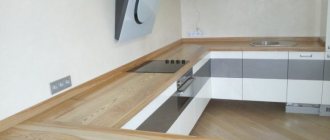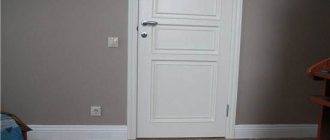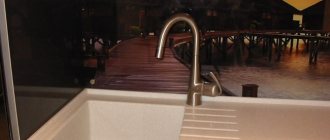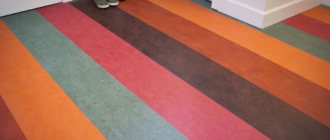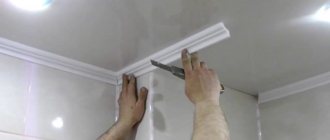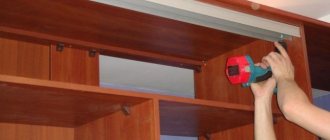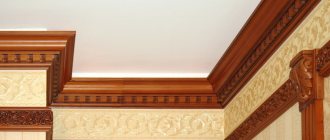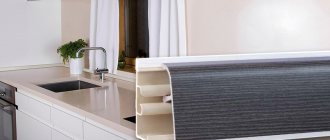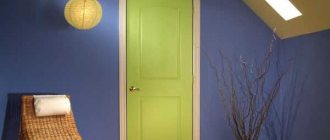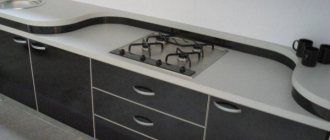Hello, dear friends! Hopefully the kitchen renovation is coming to an end. You have chosen the right set, and also found each item its place. But we still need details. For example, an aluminum baseboard for a kitchen countertop.
Basically, it is ordered simultaneously with the headset. But situations are different. Including wear and tear of the old element.
But why aluminum? What are its strengths and weaknesses? Will installation be a problem if you don't know how to mount it? I will try to answer these questions.
No. 4. Kitchen baseboard shape
According to the shape of the outer part, the kitchen plinth can be:
- triangular;
- rectangular;
- flat;
- rounded;
- curly
The width of the plinth is chosen based on which gap needs to be closed. Moldings are usually sold in lengths of 3-4 m along with all the necessary fittings: plugs, corners and connecting elements.
Plastic and aluminum skirting boards usually consist of two parts: a base, which is attached to the tabletop with self-tapping screws, and a decorative insert, which snaps into place after the base has been installed. Stone and some aluminum planks are available in monolithic form. There are also skirting boards that consist only of a base, in which any decorative material is then fixed. This is convenient if the set was made to order from some specific material. Usually one of the parts of the baseboard is equipped with a silicone seal to ensure complete tightness and protect the ends of the furniture from the slightest drops of water.
Depending on the type of attachment to the tabletop, there are three types of skirting boards:
- the base (mounting rail) is completely covered with a decorative strip, on which there are silicone strips at the top and bottom to seal the structure. The connection of the elements is ensured by special elements on the base and on the rail. Plastic moldings are usually arranged in a similar way;
- The silicone inserts are located on the mounting rail, and the outer part is just a decorative strip. This design is more reliable and is typical for aluminum skirting boards, less often - plastic ones;
- the third option is used only in aluminum skirting boards. The base has a small area and is attached to the tabletop; it is also equipped with a silicone strip. The decorative strip is installed on top; it has a special groove in it in order to expose the upper part of the sealant.
Features of aluminum
Many people are interested in why aluminum baseboards are so good for countertops in the kitchen. After all, there are wooden, MDF, plastic, and other analogues.
Aluminum is good in terms of cost/quality ratio. The surface of products comes in several types:
- unpolished;
- painted;
- polished;
- raised;
- with an image;
- combined colors, etc.
Removable moldings and replaceable decorative inserts are available for sale. They are glued immediately after installing the base.
If over time the surface loses its appearance, then you can change the overlay at any time. The basis will remain the same.
The ability to choose a color allows you to choose the baseboard to match your kitchen set, tiles, splashback and other elements.
High heat resistance allows aluminum to maintain its properties and integrity when placed near cooking surfaces. Aluminum goes well with different countertop materials.
This option is perfect when installing a countertop instead of a window sill.
To make everything look logical and harmonious, use aluminum to frame the table top and base plinth. This combination looks impressive and is also effective.
Installation of aluminum plinth
Next, we’ll look at how to attach the baseboard to the tabletop. To begin with, we will take a closer look at the installation technology of the aluminum version, since it is still used in kitchens more often than any other type.
Typically, this type of kitchen plinth comes with:
- Tabletop mounted base:
- Decorative part;
- End caps;
- Corner elements;
- Connecting elements.
The table plinth consists of a base strip and a decorative part.
Installation of kitchen plinth for countertops is carried out in several stages:
- The base frame is being attached. Usually this is a strip made of thick plastic. It needs to be screwed to the tabletop with self-tapping screws;
Important: Do not mount the plank base to the wall. The tabletop may move during use.
As a result, a gap will form between it and the wall, into which debris will begin to fall. If the tabletop is equipped with an apron, the plastic base can be attached to it.
- How to set the base? This is done simply. Press the bar firmly to the surface, bring the self-tapping screw to it and screw it in with a screwdriver. The pitch between fasteners should be about 30cm. In this way, secure the base wherever the baseboard is supposed to be installed. During installation, insert the strips into the corner and connecting elements;
Installing the base strip on the screws
In the corners of the tabletop, corners are snapped onto the strip. Where necessary, connecting elements are installed;
Special elements are snapped into the corners
- Next, the baseboard is actually attached to the tabletop. Take the aluminum strip, press it firmly against the base and press down. As a result, it will snap into place. Pass the planks along the entire length, pressing and thereby securing them to the base. During the installation process, insert them into the corner and connecting elements;
- At the last stage, the end cap is installed. It is installed by snapping it onto the bar.
Installing skirting boards for countertops. Attaching the end cap
Tips: In order for the decorative kitchen border to more reliably cover the gap between the wall and the countertop, the surface of the latter can be covered with silicone sealant before installing the base strip. To strengthen the fastening of the end caps, they are additionally coated with PVA glue.
This is how the baseboard is installed on the countertop. The video below may help someone understand the intricacies of its installation technology better:
[su_youtube url=”https://www.youtube.com/watch?v=1FN2Jmu_E_U”]
Some recommendations
You now know how to install a kitchen plinth for an aluminum countertop. The plastic one is mounted using approximately the same technology. Corner elements can be attached not at the first stage of installation, but at the last. In this case, they are put on the decorative strip itself before snapping it onto the base.
Fastening the kitchen plinth to the countertop. Plastic strips are mounted in the same way as aluminum strips
It is best to cut soft plastic kitchen skirting boards with a sharp construction knife. Aluminum components can be sawed with a hacksaw or grinder.
Aluminum plinth can be cut with a hacksaw
Important: The planks should be cut to length after they are attached to the base. In order for the decorative border to fit flush onto the tabletop, the thickness of the side wall of the end cap should be taken into account. This video clearly demonstrates how to install a plinth on the tabletop if it is made of plastic:
This video clearly demonstrates how to install a plinth on a tabletop if it is made of plastic:
[su_youtube url=”https://www.youtube.com/watch?v=SHPV3YY6RH4"]
As you can see, the installation process is not particularly complicated. Almost any home craftsman can attach a kitchen plinth to the countertop.
Advantages and disadvantages
Aluminum plinth - the most durable and practical option
An aluminum tabletop plinth is indeed more expensive than a plastic one, but this fact cannot be perceived as a disadvantage: its price is justified by its higher strength and durability. Otherwise, we can note, in addition to those already listed, the continuous advantages that aluminum plinths have:
- heat resistance;
- convenience and ease of care;
- There are various modifications with replaceable color finishes;
- has different types of coatings: simple, embossed, polished;
- you can purchase just the molding or complete with colored tape, which is easily replaced;
- functional and decorative.
Aluminum plinth with a single-color polymer coating in standard colors
If the molding is not initially included in the kitchen furniture set, but the decision to install it has been made, when choosing a baseboard you need to pay attention to the following factors:
- the profile must be selected in accordance with the color of the countertop;
- the material of the working surface and baseboard must be identical;
- the molding can be the same color as
the furniture fittings.
Narrow aluminum plinth for kitchen interior
When choosing, not only functional qualities are important, but also the aesthetics of the kitchen design, which will make it the warmest and most comfortable place, regardless of the size of the kitchen space.
An excellent combination - a countertop made of artificial stone and an aluminum baseboard in the color of the fittings
No. 3. Kitchen baseboard material
The most common options are plastic and aluminum. Stone, ceramic, wooden and MDF skirting boards are also sold.
Kitchen plinth made of plastic
Plastic skirting boards for countertops are produced on the basis of polyvinyl chloride by co-extrusion. From the molten mass you can create a plinth of any shape and size. The necessary decor is obtained either by dyeing in the mass, or laminated with a film simulating the texture of noble materials. Typically, molding is decorated to match different types of wood and stone types. The texture of the baguette may differ: if the products are glossy and matte, smooth and shagreen.
The main advantages of plastic skirting boards include:
- nice appearance and a wide variety of colors, so there should be no problems with selection - there is an option for any interior and set;
- affordable price. Plastic molding will cost less than others;
- ease of installation;
- availability of space for laying wires;
- high resistance to moisture and chemicals;
- resistance to corrosion and rotting;
- elasticity, due to which the plastic plinth can fit tightly against a slightly uneven wall. This type of plinth is also used when working with complex curved shapes.
Not without a fly in the ointment:
- plastic is afraid of high temperatures, so close proximity to the hob can be disastrous;
- at low temperatures, plastic becomes brittle and can be easily damaged, so it is not recommended to use it in the kitchens of country houses and other premises where people live irregularly;
- not the highest mechanical strength.
Aluminum kitchen baseboard for countertop
Looking ahead, we note that this is the most preferable option in terms of price and quality ratio. Aluminum plinth can have a polished, unpolished or embossed surface. They also produce aluminum moldings with a replaceable color insert. The latter is sold in a small roll, is glued after installing the baseboard and, when dirty, can be removed and replaced with a new one. This color finish is chosen to match the color of the set, countertop or other elements.
The main advantages of aluminum skirting boards:
- high mechanical stability;
- heat resistance, so the distance to the kitchen stove can be minimal - the baseboard will not be damaged;
- resistance to chemicals, sunlight and moisture;
- ease of care;
- high durability;
- ease of installation;
- Great looks and versatility. An aluminum baseboard will look great with most countertops made from cheap materials, and will also be a harmonious addition to expensive stone countertops.
The only downside is the price, but the difference in cost between plastic and aluminum skirting boards is not very significant.
Designers recommend combining an aluminum plinth for the tabletop with the same base plinth - it will look balanced and harmonious.
Kitchen plinth made of other materials
In addition to the most popular plastic and aluminum models, you can also choose a more exclusive skirting board:
- A solid wood kitchen plinth will be a beautiful addition to a wooden countertop. Everything will look gorgeous, but even the least active culinary processes will be accompanied by splashes of water and dirt, which will have a detrimental effect on the wood. If it is impossible to choose another material, then the molding will need to be very well treated with protective varnishes;
- MDF plinth is a little more resistant to moisture than wood, but also more fragile. The top of such a baguette can be painted, finished with veneer or thin lamination, so there should be no complaints in terms of appearance and its variety;
- plinth made of natural or artificial stone looks chic and is highly resistant to moisture, high temperatures and sunlight. This is a very durable material that costs a lot. A natural stone baguette is generally a luxury. Stone plinths are mounted vertically, as if they are leaning against the wall. A significant disadvantage is that the wires cannot be hidden in such a molding;
- Ceramic skirting boards are used extremely rarely and are suitable for countertops decorated with ceramic tiles. In terms of performance characteristics, this is a very good option. It, like tiles, is not afraid of high temperatures, moisture, aggressive chemicals, and is durable and easy to maintain.
Why is it needed?
Before you buy yourself an aluminum plinth for your kitchen countertop, you need to understand its functional purpose.
The plinth itself can be narrow or wide, rectangular or square.
Cleanliness in the kitchen is not only work, but also the efforts of the housewife. Even when thoroughly washing countertops and cabinets, debris, crumbs, pieces of food, etc. get into the gaps between them. It is difficult to remove all dirt from there. You'll have to move the entire set.
There is also the issue of protection from moisture. Even if you have a moisture-resistant countertop, its ends remain vulnerable. Water flows in there every now and then. It begins to affect the material and penetrate into microcracks.
When making the same countertop from tiles, take care to install the baseboard. This solution was offered to housewives in order to keep the kitchen clean, and also not to move furniture for cleaning.
Aluminum plinth - features, advantages and disadvantages
The tasks of floor plinths do not end only with protecting the junction of the floor and walls.
To a large extent, it protects the lower part of the walls from dirt, mechanical damage and moisture used when cleaning the room. Skirting elements made of wood and MDF quite actively absorb moisture from the air, changing their geometric dimensions.
Aluminum satisfies these requirements perfectly.
The plinth made from it has the following positive qualities:
- strength – inherent in any metals;
- resistance to moisture and aggressive substances;
- resistance to temperature changes and wear makes it possible to install aluminum skirting boards not only in heated rooms;
- the flexibility of the elements allows you to use them to design not only straight surfaces, but curved ones;
- ease of use - periodically the baseboard just needs to be washed with soapy water;
- ease of installation;
- long service life;
- a large selection of products of various designs on sale;
- wide functionality.
These products also have disadvantages that need to be taken into account when choosing:
- quite high cost;
- the need to follow certain rules when cleaning;
- softness of the metal, leading to dents due to accidental impacts.
What are the advantages
Now let's discuss the aluminum baseboard for the kitchen countertop from the perspective of its strengths and weaknesses.
There are many advantages here. They are as follows:
- Heat resistance
. The material can withstand high temperature loads. It can be safely mounted near the stove and oven. The main thing is that the tabletop can withstand it. Aluminum will definitely do the job; - Design variety
. Don't think of aluminum as just a piece of gray metal. Nowadays it is decorated and processed in different ways. This gives a wide choice of skirting board designs; - Selecting coverage options
. These are embossed skirting boards, polished, as well as unpolished and painted; - Functionality
. Aluminum is practical, easy to use, and also suitable for various solutions in the kitchen; - Availability of removable moldings
. This expands the decorative capabilities of the products. At any moment, replaceable elements completely change the perception of the plinth; - Impressive service life
. Plastic, MDF and other materials cannot boast such service life; - Easy to install
. If you are a beginner, you can definitely handle the installation. All you need is a drill or screwdriver. Fasteners are usually included in the kit. 102 hour job to install baseboard around the entire perimeter of the kitchen.
I'll stop there. I think this list of benefits is enough.
Installation of skirting boards
Preliminary measurements and purchase of necessary materials. It is necessary to determine the exact dimensions of the plinth, how many plugs and corners will be needed. The base must be grease-free, clean and dry. Preparatory work includes removing a layer of glue, grease and dirt if there was already a plinth in this place
Please note: Special products and household chemicals are used to degrease the base. Afterwards you need to wipe the tabletop dry.
Installation of the baseboard on the countertop is carried out using liquid nails or using self-tapping screws, depending on the type of baseboard you have chosen. If these are plastic products consisting of a plastic base and a decorative overlay panel, then glue is applied to the base. First, separate the base of the baseboard and the decorative trim. Glue the base of the baseboard to the tabletop
Make sure it is securely fastened along its entire length. Corner joints are immediately installed in the corners. Please note: You should not attach the molding to the facing of the work wall, because the table top may move, so that a gap will form again.
For self-tapping fastening, small wood screws are used. Carefully screw the plastic corner to the tabletop using a screwdriver. The spacing of fasteners is 30 cm.
If the countertop is made of natural stone, the holes for the dowels must be drilled in advance. Use a drill for concrete, the same self-tapping screws are used - 16 mm.
- Cut the decorative trim panel using a paint knife or hacksaw. To cut aluminum products, use a hacksaw or grinder. It is necessary to measure the overlay panel with a gap of plus 5 mm in order to fit it behind the corner elements.
- Insert the panel, wrap it around the corner. After this, with a slight movement, the panel falls into the groove and snaps into place.
- After installing all the skirting boards, side plugs are inserted at the ends. Use silicone to secure the plugs. Apply silicone to the plug and hold it until it is completely secured.
note
Immediately remove any remaining silicone from the plastic corner, as this will be more difficult to do later.
Installation subtleties
When ordering a kitchen, installation of all elements is included in the cost of the specialist’s work. But there are times when you want to try your own and save money at the same time. To carry out independent work, you need to know the basic rules for handling kitchen plinths. Most often, when purchasing a set of skirting boards, instructions with installation rules are located on or inside the package. If this is not the case, then you need to take into account the main stages of the work.
- First, check the kit's contents. All bolts and silicone gaskets must be in place. Otherwise, you need to contact the store with a receipt and get the necessary components.
- Then you need to take care of the tools that can be used to cut the selected type of material. For plastic, chipboard and aluminum, a hacksaw for metal will suffice. Its small teeth will ensure a neat, clean cut. If the baseboard is ceramic, then you will need a more serious unit, such as a grinder with a special cutting wheel for ceramics. It’s also worth preparing a ruler and pencil for measurements, and a screwdriver for installing screws. Depending on the type of fastener, a drill with drill bits may also be useful.
- Next, you need to measure the length of the strips to be cut, then measure them again, and only then start cutting. First, the lower part of the panel is cut and fastened, and then the upper decorative part is inserted or snapped into it.
The design of modern skirting boards is approximately the same, so you can consider in more detail the method of fastening using the example of one type of skirting board - an aluminum kitchen corner-border. Such a kit must include the following elements:
- mounting base;
- decorative panel;
- corner convex and concave elements;
- end caps;
- jumpers.
First you need to establish the foundation. In an aluminum plinth it is attached to the tabletop. The basis is a thick plastic strip, in which there are holes for self-tapping screws.
Please note that this strip is not mounted on the wall for technical reasons. Over time, the tabletop may shift, which will lead to gaps appearing between the baseboards, and accordingly, debris will begin to get there.
But if the set includes an apron, then you can install a plinth on it.
Direct fastening can be done using a screwdriver or drill with an attachment. The plastic strip must be pressed tightly against the tabletop and, inserting a screw, screw it in. The standard distance between screws should be about 30 cm. During the installation process, you need to lay the base so that it fits into all the gaps and is inserted into the corner joints. Laying is carried out gradually with the sequential installation of all necessary elements.
After completing the installation of this element, you can snap the plugs on the sides. To do this, you also need to press them a little. If any of the elements does not fit into the groove, do not immediately press on it with great force. It is better to first check whether a screw or chips have gotten into the fastening. If you try to latch fasteners with a foreign object, you can simply break the latches.
To make the gaps more tight after installation, you can coat the edges of the plinth with a small amount of silicone. Thanks to its transparency, it will remain invisible, but will create the necessary level of protection. It is also worth taking care that the end caps do not fly off during operation. To do this, they need to be glued to a base of PVA glue.
To learn how to install a plinth on a kitchen countertop, see the following video.
Kinds
Kitchen skirting boards are distinguished by shape and material of manufacture. Both criteria are of great importance not only for a harmonious appearance, but also for reliable sealing of gaps. Depending on the material of the product (baguettes), they are as follows:
- plastic;
- aluminum;
- ceramic;
- metal (possibly chrome plated);
- Chipboard.
If the kitchen is made to order, then the baseboard is included in the package. Most often it is made of the same material as the headset itself. But when decorating a room yourself, you need to select such an element based on the external features of the purchased countertop, its texture and the color of the cabinets. The most economical and flexible are plastic and metal baguettes. They are characterized by their low cost and excellent compatibility with any surface. The metal version is universal if you have the same sink, with which it will create an excellent tandem in any case. And plastic skirting boards can be selected thanks to a wide range of colors.
But each material has its own distinctive features, which it is better to know about in advance. Thus, plastic products are produced by adding color to a liquid material. It is then covered with a layer of laminate, which gives it the appearance of different types of materials, such as wood, stone or tile. The price of this frieze, as well as its moisture resistance and ease of installation, are undeniable advantages. A special feature of the polymer material is that the plinth made from it can be flexible. However, there are also a few disadvantages. Plastic is fusible and cannot be placed next to a periodically heated stove, because when exposed to heat it begins to release a harmful substance - formaldehyde. In addition, if installed incorrectly, a narrow strip of plinth may crack. And finally, although its appearance imitates expensive materials, it looks cheaper than natural ones.
Aluminum modifications are heat-resistant, are also inexpensive and are not afraid of moisture. But these friezes are produced in only one color - metallic, which makes their use impractical in the absence of a sink or other decorative elements made in this tone. When choosing, edge holders, which should be transparent, are also of great importance. Otherwise, the assembled composition will look cumbersome.
Ceramic skirting boards have all the positive qualities of the previous types, since this material is resistant to moisture and high temperatures. But in a decorative sense, it is combined mainly with the same countertops. In addition, the price of ceramic cutters is higher, but it is justified by its long service life. Ceramics retains its appearance throughout its entire service life, as it is scratch-resistant. However, such material can be damaged due to its causticity. Such a plinth can crack not only during installation, but also during operation. For example, if a knife or any other heavy object accidentally falls on it.
Metal skirting boards are most often chrome-plated, which protects the cutters from corrosion. This material is easy to clean, is not afraid of heat, but is not used in decoration without the presence of elements of similar quality in other parts of the kitchen. In addition, the cost of such a product is not the smallest. Chipboard plinth is an excellent addition to a wooden kitchen, as it is not afraid of moisture. Its price is affordable for any category of buyers. Its main disadvantage is considered to be low heat resistance, as is the case with plastic. It is better not to use this flammable material near the stove. Its combustion is accompanied by an unpleasant odor and black smoke.
In order for the plinth to harmoniously combine with the overall design, it is necessary to take into account its shape, which can be as follows:
- curly (corner);
- flat;
- triangular;
- rectangular (border);
- rounded.
What are the disadvantages
See also
How to effectively age furniture at home: choosing a method
Some will say that the main disadvantage is the high price.
I don't agree. Go to Leroy Merlin or similar stores and explore the assortment.
Yes, aluminum plinth will be more expensive than plastic, wood and MDF. But it's logical. Such products are more reliable, stronger, and also have high heat resistance and durability. There is every reason for them to cost more. This is a reasonable price.
But there are downsides. You can glue them. But over time, aluminum peels off. Therefore, it is better to use self-tapping screws. Unfortunately, you will have to damage the tabletop.
Aluminum requires maintenance. It is better not to use aggressive chemicals, as well as abrasive cleaning products, here. But regular dish soap will do him no good. A soft, damp sponge and the place is clean.
Over time, the material darkens. He does not like contact with abrasives and acids. But what are replacement moldings for? Exactly.
How to attach a baseboard to a countertop
First, let's determine what kind of baseboard you need. We will choose one that is harmonious in style and color scheme. Fortunately, the variety doesn't stop there.
Now on the market you can find skirting boards that differ: in the type of materials from which they are made, in the shape of the surface, in the types of silicone sealing liners, and in the method of fastening. It's easy to get confused by the variety of offers.
We tried to systematize all available information and present it in an accessible form. Learn how to properly and beautifully attach a plinth to a tabletop.
Undoubtedly, the right skirting board should perform at least two useful functions, including:
- protective, protect against the flow of liquids between the table top and the wall, protect from dust and dirt;
- aesthetic, to give a finished look to the countertop and the kitchen as a whole;
- auxiliary, used to place hidden electrical wiring.
Manufacturers offer a wide range of skirting boards. According to the type of material from which the plinth for kitchen countertops is made, they are:
- aluminum;
- plastic;
- combined (made of metal in combination with another material);
- ceramic, artificial stone, similar;
- wooden.
Based on the shape of the surface of the plinth, there are:
- Flat - skirting boards fit tightly to the wall, are often made of metal, can only be used on very flat surfaces, and save table space (Figure 1);
- Triangular with or without mounting space (Figure 2.1);
- Volumetric (shaped) with or without mounting space, with liners made of colored plastic, which is selected to match the tone of the tabletop (Figure 2.2);
- Combined into one with the tabletop (Figure 3).
Illustrations for the above
Figure 1. Flat plinth in color with the wall above the table
Figure 2.1 Triangular plinth with two mounting compartments and fastening with one clip
Figure 2.2 Curved plinth (without liner) without installation space with external silicone inserts
Figure 3. Plinth combined with tabletop
According to the methods of attaching silicone liners that protect against moisture and dirt:
- external (Figure 4);
- internal (Figure 5);
- combined
Figure 4. External silicone inserts (rest against the surface of the table and wall)
Figure 5. Internal silicone liners (rest against fastening elements)
According to the method of fastening to the tabletop:
- Removable (fastening with a clip, a metal guide, a groove in the cable channel);
- Stationary (fastening with screws or liquid nails);
- Fastening to the tabletop (top, end, combined).
We have listed all available types of skirting boards. Now it’s the turn to talk about how to attach the baseboard to the tabletop. How to do it correctly, without spoiling the appearance and maintaining the aesthetic appearance of the kitchen desktop for a long time. First, let's remind you what not to do:
- Do not attach the baseboard to the wall. Because a plinth fixed to the wall will not perform its main function - protection from moisture and dirt. The plinth fixed in this way is subject to deformation even if the table moves slightly. And finally, it is not advisable to damage the wall.
- Do not use sealants or liquid nails. Because the space between the baseboard and the table surface will very soon lose its attractive appearance. Dirt will inevitably accumulate in a microscopic space, and it is impossible to remove the accumulation of dirt from under tightly glued surfaces. It is difficult to replace a tired baseboard with a new one.
Return
Sequence of work: how to attach a plinth to a tabletop
- Based on the above modifications of skirting boards, choose the one that suits the design and other required criteria.
- Take measurements of baseboards, corners and end elements (plugs).
- Prepare the installation site for skirting boards from dust and degrease.
- Install the tabletop in relation to the wall in such a way as to move it as far as possible, try on the baseboard in the same way as it will be installed. Check the installation quality visually and using a spirit level. If the table is not horizontal, then use the screws on the legs to adjust the horizon. Secure the position of the legs.
- Make markings for the guides on which the baseboards will be attached.
- Attach the guides or inserts to the tabletop. Try to press the silicone inserts as tightly as possible to the base of the table, secure them with self-tapping screws or liquid nails.
- If adhesive fastening was used, then allow the glue to bond the surfaces.
- We apply and snap the decorative trim.
- All the plinth is secured, we install the end caps.
Figure 6. End cap, before installation on baseboard
Return
What is it and how does it work?
Durable Aluminum Kitchen Countertop Skirting
Usually, when talking about baseboards, we imagine a long strip covering the edges of the flooring, which hides imperfections and prevents dust and dirt from accumulating in the corners and edges of the room. The plinth for the countertop performs the same functions. Made in the form of a tape of various widths and materials, it will reliably cover the niche between the table and the wall and will not allow liquids to flow in, crumbs to fall to the floor, attracting hordes of cockroaches, or debris to accumulate on the floor behind the table.
Aluminum plinth for tabletop, with PVC mounting strip
In a number of models of kitchen sets, especially those made of expensive materials, the plinth for the countertop is already included in the kit and is made of material identical to the furniture, the corresponding color and format. But even if you don’t have it, purchasing such a molding for the countertop will not be difficult.
Skirting for countertops made of artificial stone, matching in color and material
Installation
If the kitchen is ready, then the assembly and installation of the baguette is included in the work of the master
When assembling furniture yourself, it is important not to forget and attach the frieze correctly. To ensure everything goes well, we recommend that you read the detailed instructions
Checking the contents
Before installation, double check that the entire kit is in place. It should include the following elements:
- baguette base, which is attached to the wall and tabletop;
- decorative part;
- plugs;
- external and external corners, joint connectors;
- fasteners.
plinth plugs internal corner for plinth
Installation
For the installation to be successful, you must follow these steps:
- Measuring the tabletop. If the baguette is too long, it can be shortened using a saw with fine teeth. The tool is suitable for cutting frieze of any material.
- It is necessary to take the base and place it at the installation site.
- Use a hammer drill to drill holes through.
- We insert the plastic part of the fastening into the wall, attach the base part and screw in the metal part. For convenience, you can use a screwdriver.
- If you are attaching a baguette to a tabletop, then use ordinary self-tapping screws.
- We install the decorative part.
- You need to put caps in the edges, as well as in the outer and inner corners.
- All joints must be treated with silicone sealant.
On a note! If you need to fix the baseboard to the tiles, you must use a special drill that will prevent cracking.
installation of the main part installation of the decorative part and plugs
How to attach a plinth to a tabletop
There are two main methods of attaching kitchen skirting boards - with self-tapping screws and glue.
Fastening with self-tapping screws
This is the most common and reliable installation method. The technology is as follows:
Separate the decorative baseboard panel from its base. Decide on the number of required mounting elements: plugs, internal and external corners. Pay attention to the internal and external corners of the walls in the work area. If instead of right angles there are rounded elements (for example, an inserted corner profile for tiles), make the necessary adjustments to the mounting corners (cut them to the desired shape). Before starting work, take measurements of each of the segments of the future composite plinth structure, cutting the base taking into account the size of the mounting elements. Pay attention to the design features of the set of mounting angles and plugs
In some models they are attached to the base of the border, in others - to its front decorative panel. The length of the segments of all components depends on this. Clean the work area thoroughly. If the baseboard does not have a high-quality elastic seal around the edges, apply a small amount of silicone to the countertop before installation, having previously degreased the surface. Start installing the base from the simplest area, from the corner, screwing in the screws in increments of 20-30 cm. It is recommended to pre-mark the drilling locations by pressing on the base with an awl or a sharp screwdriver. If there are holes in the base of the plinth, this simplifies the matter. Use the “correct” self-tapping screws for installation: galvanized or brass. "Black" ones can become rusty over time. Select the size of the screws based on the installation method (to the wall or to the tabletop) and the model of the baseboard. When mounting to a wall, use dowels. Install the face trim by snapping it onto the base. Some curb models require you to first install the mounting bracket. Close the ends of the plinth with plugs and place them on glue for reliability. If you have problems with the front panel snapping into place, check the mounting of the base. Sometimes it is necessary to reduce the pitch of the screws, or loosen or tighten some of them.
Glue mount
Liquid nails are used as glue; for artificial stone borders, special two-component acrylic-based adhesives are used. The glue must match the color of the countertop, otherwise the joints will be visible. Glue is applied using manual dosing guns.
The algorithm for performing the work is similar to the first method:
- Detach the baseboard from the decorative panel.
- Take measurements and cut the required sections of the future composite structure, taking into account the size of the mounting elements.
- Thoroughly clean the work area and degrease surfaces.
- Apply glue in a thin, even layer along the entire length of the segment. Place the base of the baseboard and press it firmly with your hands. Wait until the glue sets. Install the inner or outer mounting bracket.
- Measure the required length of decorative panel. To do this, insert one end into the corner and snap it onto the base. At the other end, mark where the panel will be cut, approximately 2mm from the edge of the tabletop.
- Cut the panel to the desired location and snap it all the way into place. Place the plug on the end of the plinth and place it on the glue to be secure. If measured correctly, it should be flush with the end of the countertop.
- Install the remaining sections of the composite plinth structure in the same way.
Borders made of artificial stone, marble or granite are installed by professionals. Fitting and installation are carried out together with the installation of the countertop and the entire kitchen unit. It is not recommended to do this yourself: you need a special tool and experience working with stone.
